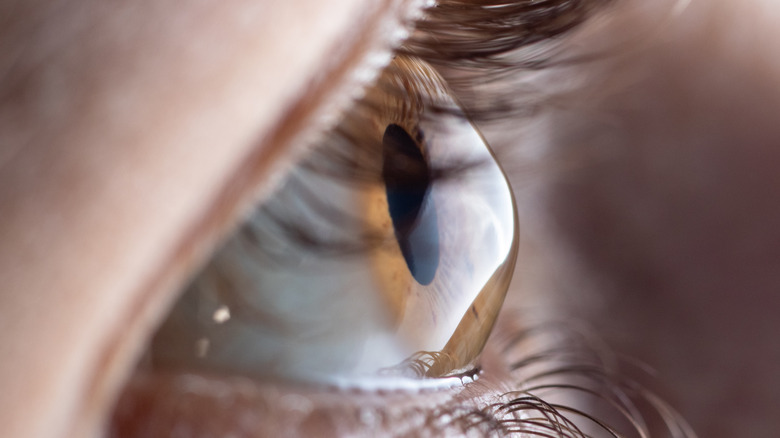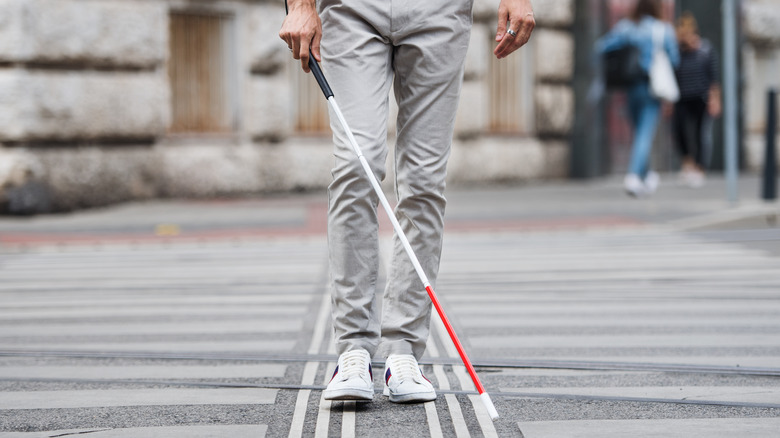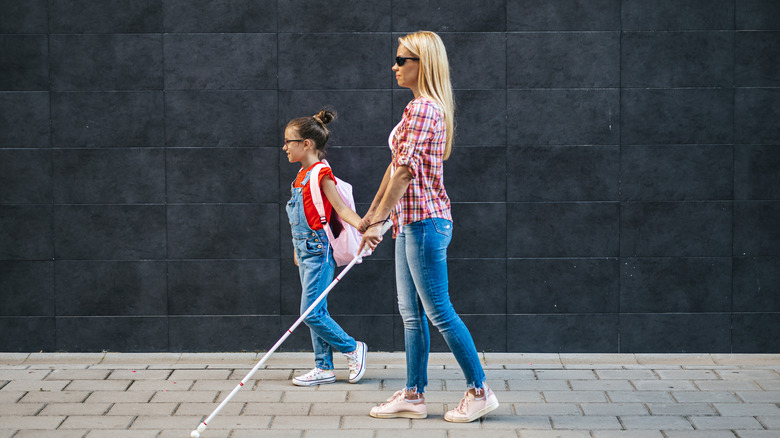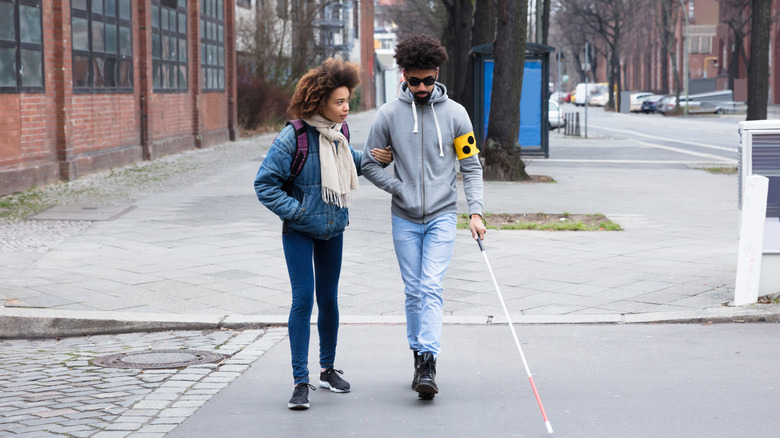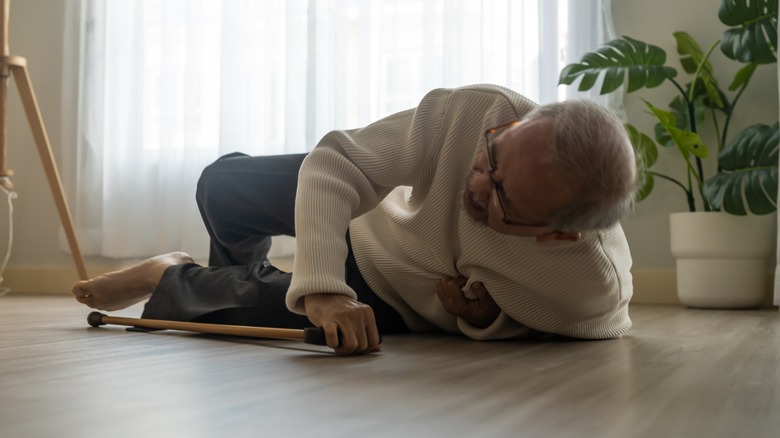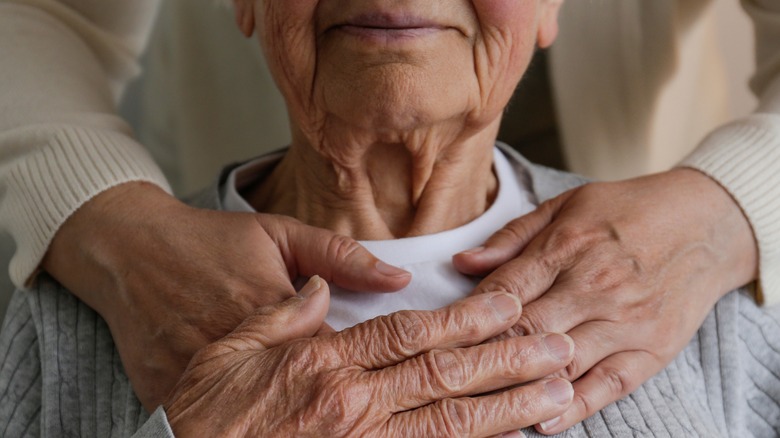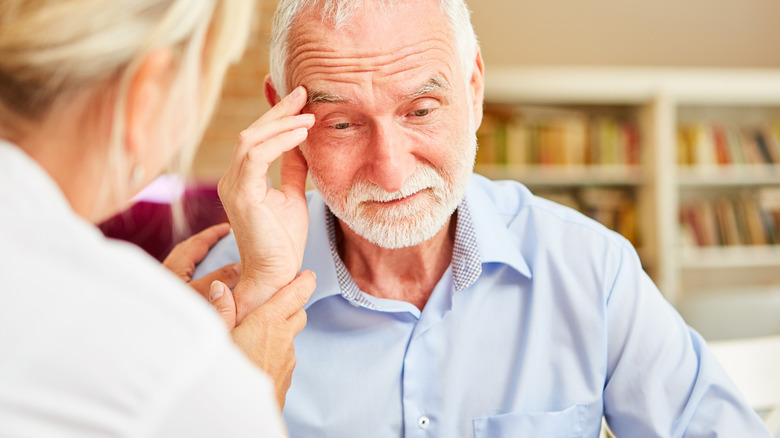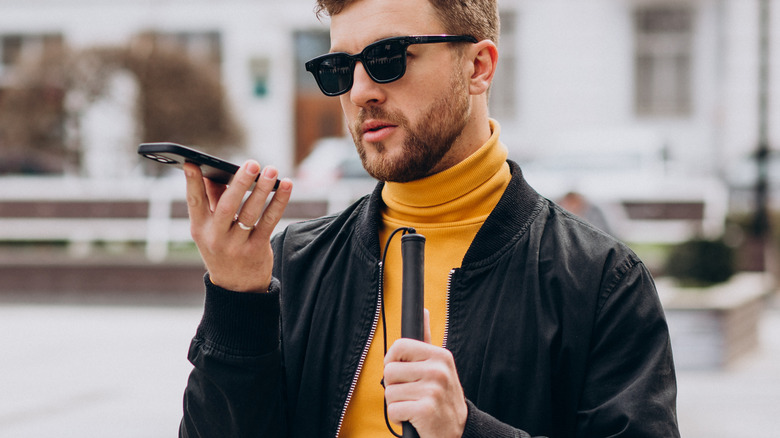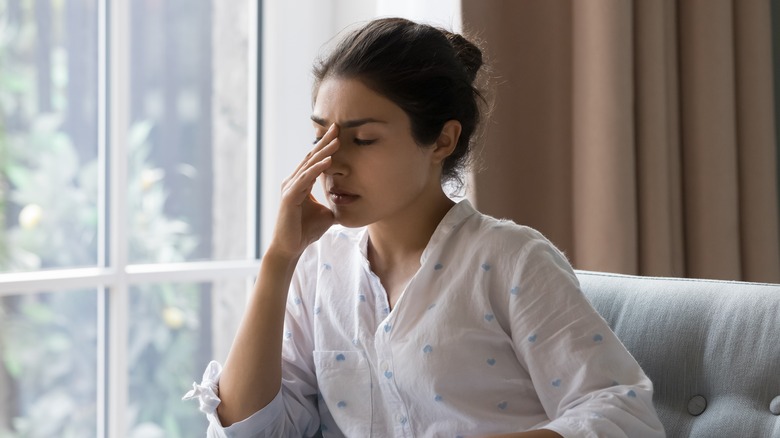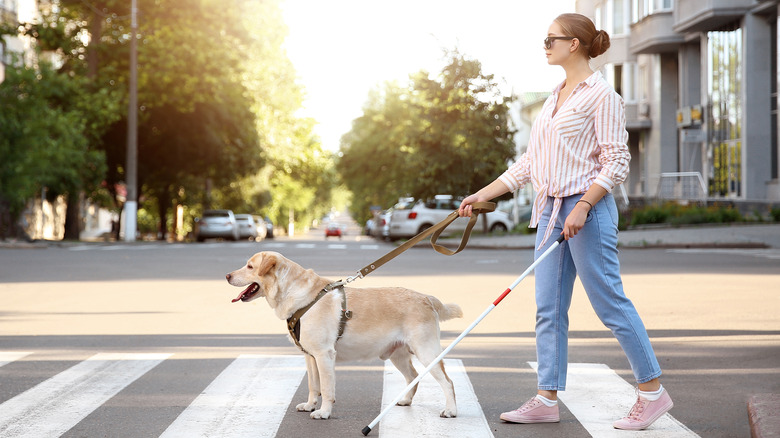The Side Effects Of Losing Your Eye Sight
Vision loss is a challenging condition that can affect all aspects of a person's life, from their ability to work and do recreational activities they once enjoyed to their physical health. You can lose your eye sight at any age, but it's most common in older adults. According to the Centers for Disease Control and Prevention (CDC), more than 4 million Americans over the age of 40 have low vision or are legally blind. The most common reasons for loss of eye sight are age-related, including age-related macular degeneration, glaucoma, diabetic retinopathy, and cataracts.
For people above 18 years of age, blindness or other vision problems has been ranked among the top 10 disabilities, and has a strong impact on overall health and well-being (via the CDC). Vision problems can result in social isolation and family stress, and they can increase the risk of other health conditions and early death. If you or a loved one is facing loss of eye sight, you can work with your doctors and care providers to reduce the impact of vision loss on physical and mental health once you know what the possible effects are.
Types and degrees of vision loss
Visual impairment is classified in several groups, from mild to severe and full blindness (via the World Health Organization). Severe vision impairment and blindness have the biggest effect on the individual. Severe visual impairment is classified as distance visual acuity "worse than 6/60 to 3/60," and blindness is distance visual acuity poorer than 3/60. But even mild and moderate visual impairment that isn't treated can take a negative toll. Mild impairment is categorized as distance visual acuity more severe than 6/12 to 6/18, while moderate impairment is poorer than 6/18 to 6/60.
Per the Cleveland Clinic, there are several types of blindness. With partial blindness (also called low vision), the individual still retains some eye sight. Complete blindness — a rare occurrence — means completely lacking the ability to see or perceive light. Legal blindness is described as central vision that is 20/200 in the better eye (even with the use of corrective lenses) or significantly reduced peripheral vision. Blindness at birth is called congenital blindness, which may be caused by birth defects or inherited illnesses. Lastly, nutritional blindness can occur from a lack of dietary vitamin A which, if left untreated, may damage the front surface of the eye. This condition can make it challenging to see at nighttime or under low light conditions.
Decreased quality of life
Vision loss results in decreased quality of life, which is broadly defined as an individual's ability to be "healthy, comfortable, and able to participate in and enjoy life events" (via Britannica). Furthermore, the World Health Organization defines quality of life as "an individual's perception of their position in life in the context of the culture and value systems in which they live and in relation to their goals, expectations, standards and concerns" (via Berkeley Well-Being Institute). Quality of life involves not only quality of physical health, but also psychological well-being, level of independence, quality of social relationships, living environment, and spirituality and religious beliefs.
As it relates specifically to vision impairment, a 2011 article in the American Journal of Ophthalmology explained that quality of life is "a complex trait that encompasses vision functioning, symptoms, emotional well-being, social relationships, concerns, and convenience as they are affected by vision." A wealth of research has shown that impaired vision is associated with poor quality of life. A 2016 study in Ophthalmic Epidemiology examined data from the 2006–2010 Behavioral Risk Factor Surveillance System and found that adults ages 40 to 64 who reported poor vision also reported having more physically and mentally unhealthy days, physical activity limitations, a greater degree of disability, poorer health, and higher life dissatisfaction than those who reported having no or minimal visual impairment.
Decreased independence
Loss of eye sight makes it difficult for people to work and earn a living and take care of themselves. It reduces an individual's ability to read, take part in social activities, and pursue hobbies without significant assistance from others (via the National Institutes of Health). Even basic self-care activities like eating, showering and getting dressed requires the assistance of a caregiver. Research shows that instrumental activities of daily life, including driving, taking care of finances, and managing medication, are impacted to a greater extent with vision loss than are basic daily activities like showering and dressing.
Because it means an additional challenge to independent living, older adults who lose their eye sight have a higher probability of needing long-term care. Research published in 2003 found that likelihood of a person's nursing home placement increased by 7% for every line of reduction in their visual acuity from the baseline.
People who lose their eye sight or who have low vision are far less likely to work or seek work than people without disabilities. According to the American Foundation for the Blind, only 44% of blind or visually impaired individuals are in the workforce, compared to 79% of people who have no disability. Reduced independence and reduced capacity to work and earn a living can put significant pressure on families and caregivers, as well as reduce quality of life in those with impaired vision.
Decreased mobility
Those with healthy eye sight use their vision as the primary means of navigating through three-dimensional space. When you lose your eye sight, several parameters of your vision are affected. Changes in visual acuity reduce your ability to see details and identify shapes from a distance (via NIH). Decreased depth perception affects your ability to estimate the distance of an object and see it in three dimensions (via American Academy of Ophthalmology). Changes in your field of vision means you might not be able to see as much at once as you used to be able to see (via Instituto de Microcirugia Ocular). Lastly, reduced contrast sensitivity reduces vision quality and can make everything look hazy (via Total Focus). All of this can result in significant changes to your ability to navigate the world as you once did.
Among participants in the 2013 Salisbury Eye Evaluation study, people with visual impairment were considerably more likely to report challenges with walking and climbing or descending stairs. Additionally, decreases in visual fields were associated with reduced gait speed during navigation of an obstacle course. Among individuals who sought out vision rehabilitation programs in the Low Vision Outcomes Study, 16.3% reported mobility as one of their top vision-related complaints (via NIH).
Increased risk of falls and fractures
Changes to vision and the resulting reduced mobility among visually impaired people are strongly associated with an increased risk of falls, fractures, and other accidents (via NIH). A 2005 study found a strong correlation between frail elderly people in Scotland admitted to hospitals for hip fractures and visual impairment. Untreated cataracts was the most common reason, followed by uncorrected refractive error. Data from the 2014 Behavioral Risk Factor Surveillance System revealed that nearly 50% of older people with self-reported severe vision impairment reported having fallen in the prior year. In contrast, only 20.4% to 32.4% of elderly people without severe vision impairment reported falling in the last year (via NIH).
Because of this increased risk of falls, losing your eye sight can increase your risk of fracturing bones. Participants in the Framingham Eye Study with worse visual acuity were significantly more likely to suffer a hip fracture than those with better visual acuity (via NIH). Other aspects besides visual acuity can increase the risk. For example, in a 1995 study on women with hip fractures, poor depth perception was associated with an increased fracture risk, and a 2009 study found an increased risk in women with loss of binocular visual field.
Increased loneliness and social isolation
Loneliness is a mental state that makes you feel a lack of connection to others, while social isolation is the lack of opportunity to interact socially with others (via ResearchGate). Although the relationship between sight loss and loneliness and social isolation isn't clear, some factors involved include the functional challenges related to visual impairment, including problems with reading, mobility, and shopping. The challenges people face trying to carry out daily activities can negatively affect their mental health and decrease opportunities for social engagement, thereby increasing their risk of social isolation and loneliness. Loss of eye sight can also affect physical health, which can further reduce ability and opportunity to perform regular functional activities and pursue meaningful social interaction with others.
Some challenges that can prevent people with visual impairment from social interaction include problems organizing transportation to social activities, inadequate lighting and distracting background music at gathering places, noise levels in public places making it harder for people with visual impairment to communication, and a lack of knowledge on the part of sighted people on how to communicate with the visually impaired.
Individual adaptation to sight loss is also a key factor. Research shows that it is more difficult for older people who are lonely to adapt to vision loss. And individual mental factors, such as self-esteem, motivation, and the power to exert control over daily life, can also affect whether or not people who lose their sight experience loneliness.
Increased risk of mortality
A large-scale review and meta-analysis published in the Lancet Global Health in 2021 found that adults aged 40 and older with visual impairment have a higher risk of death from all causes than those without vision problems. According to the findings, mild vision impairment increased the risk of mortality by 29%, and severe vision impairment increased the risk by 89%. In part, this could be due to something called allostatic load (AL), which is "a measure of cumulative physiological wear and tear on the body's regulatory systems," according to research published in 2014 in Investigative Ophthalmology & Visual Science. Using an index made up of several biomarkers, including body mass index, blood pressure, cholesterol, inflammatory markers homocysteine and C-reactive protein, and more, researchers determined that worse visual acuity was associated with increased AL and decreased functional status (social isolation, depression, and decreased well-being). Combined, these increased the risk of mortality in adults 60 years and older.
Additionally, a 2009 study found increased risk of suicide among people with visual impairment, and a 2003 study found a link between visual impairment and death by unintentional injury.
Impaired cognition
When you lose your eye sight, you may experience cognitive side effects. Cognitive impairment affects the way you think, your memory, how well you learn new things, your concentration and your ability to make decisions (via the CDC). The connection between visual impairment and cognitive impairment isn't fully understood, but it may be that the loss of a sense, such as vision or hearing, causes an increase in cognitive load, alterations in the structure and function of the brain, and reduced social and emotional health, all of which can lead to cognitive deficit (via BMJ Open). In fact, it has been confirmed that hearing loss treatment can prevent cognitive impairment, but it has not yet been acknowledged that the same is true for visual impairment.
Age increases the probability for cognitive impairment, and older adults who have vision impairment appear to be at an even higher risk (via NIH). In visually impaired older adults, cognitive decline also occurs more rapidly than in those without visual impairment. The co-occurence of cognitive and vision impairments in adults over 65 is more common than widely recognized conditions affecting the elderly, such as emphysema and Parkinson's disease. Additionally, adults with age-related macular degeneration are more likely to have cognitive impairment, receive lower marks on cognitive tests and have dementia than their non-visually impaired counterparts.
How eye sight loss affects your hearing
You may have heard that losing one sense increases your other senses. That may be true for certain populations, but not for others. According to Fred Hutch Cancer Center, you are more likely to have improved hearing when you lose your sight early in life. That's because the brain adapts, and the area of the brain devoted to sight is "rewired" and assigned tasks to support other senses, such as touch and vision, according to Scientific American.
However, losing your sight as an adult (especially as an older adult) could have the opposite effect. In the Blue Mountains Eye Study, participants with age-related visual impairment were more likely to have hearing impairment (via JAMA Network). For every one-line reduction in visual acuity, the likelihood of hearing impairment increased by up to 18%. The combination of both vision and hearing loss can significantly increase the risk for dementia in older populations (via Healthy Hearing).
Increased risk of anxiety and depression
Losing your eye sight can take a major toll on your mental health. A change in your ability to care for yourself and execute your daily activities of living causes you to lose your independence and results in a major change of lifestyle. A 2012 study in Quality of Life Research determined that older people with vision problems had higher risk of experiencing depression and anxiety symptoms compared to people of the same age without vision problems and when compared to older adults without vision problems but who reported suffering from other chronic conditions.
Moreover, in a 2020 study by the CDC, one in four adults with vision loss were anxious or depressed. In this study, younger adults with visual impairment were five times more likely to experience severe anxiety or depression compared to older adults. The CDC surmises that perhaps this is because they were too young to have developed effective coping and self-management strategies yet.
Not only can losing your eye sight cause depression, but depression can worsen the effects of vision loss in some cases. A study published in 2002 in Archives of Ophthalmology found that vision loss due to age-related macular degeneration was worse in older adults with depression. Over time, increased symptoms of depression were predictive of decreased self-reported vision function, even if those changes weren't medically supported.
How eye sight loss worsens effects of other health conditions (and vice-versa)
Vision loss has a complex relationship with your mental and physical health. Losing your vision can increase the actual or experienced effects of certain physical and mental health conditions, such as depression. Research published in 2019 in the Journal of Visual Impairment & Blindness showed that older individuals with vision loss and one or more co-occurring conditions had increased probability of facing challenges in activities of daily living than those who were not visually impaired or who did not have the health condition.
Furthermore, the combination of visual impairment and cognitive impairment common in the elderly population has been linked with lower self-reported health ratings and increased disability (via NIH). Individuals with both vision loss and hearing loss also have higher risk of comorbid conditions such as cognitive deficits, depression, disability, and mortality.
Additionally, the challenges created by vision loss can make managing co-occuring health conditions more difficult. Tasks that are required for management of chronic diseases, such as self-care, transportation to and from medical appointments, and medication management are all made more difficult by vision loss, which can prevent healing of (and even exacerbate) those conditions.
Living with vision loss
If you have already started to lose your eye sight or have been told that you will, you may feel that all is lost, and that these side effects are inevitable. However, with the proper treatment and appropriate changes in your home environment and your daily routines, you can preserve your safety and independence (via MedlinePlus).
The best plan of action for you depends on your level of vision loss. If you still maintain some vision, making changes like utilizing magnifiers, high-power reading glasses, and telescopic glasses, as well as maximizing lighting, can help. You can organize your home and make it safer to prevent falls, as well as learn Braille and develop strategies for safely traveling outside your home.
World Services for the Blind encourages people to consider the benefits of being blind or visually impaired, such as being able to find a community of others facing the same challenges, never having to be the one to drive friends or family home after a night out, being a better listener, getting discounts on certain services, and being accompanied by your dog wherever you go.

